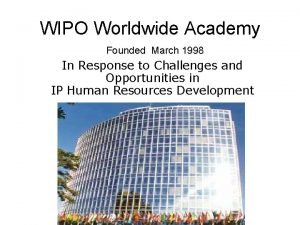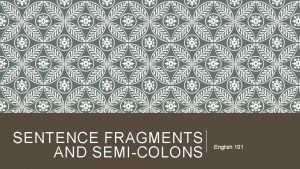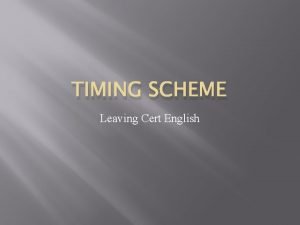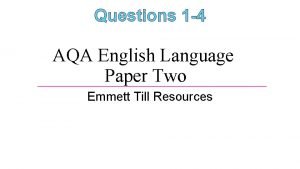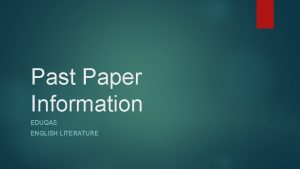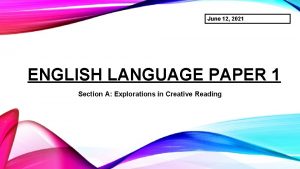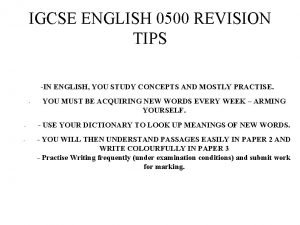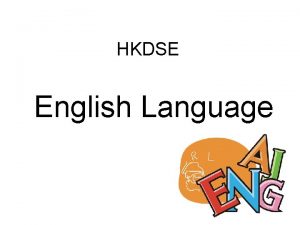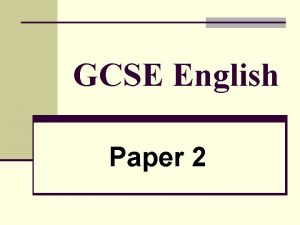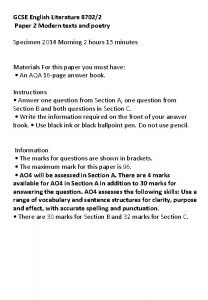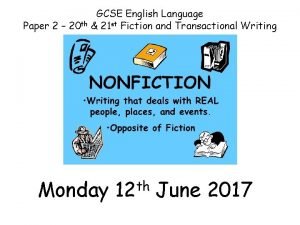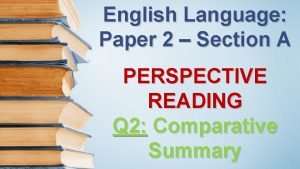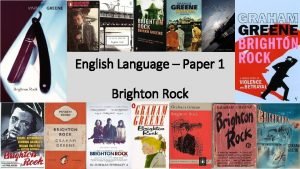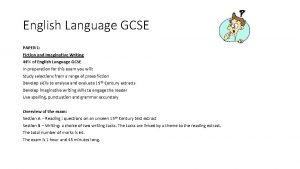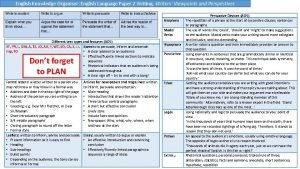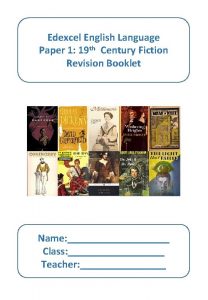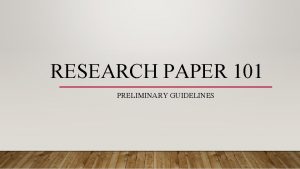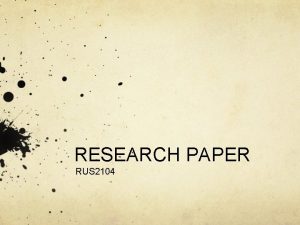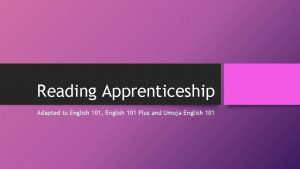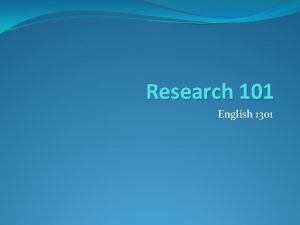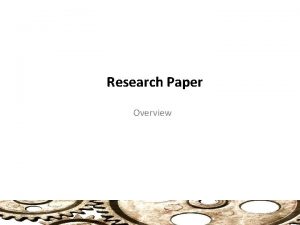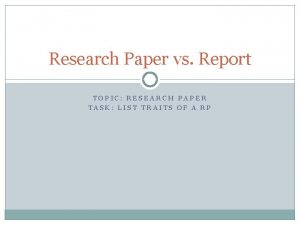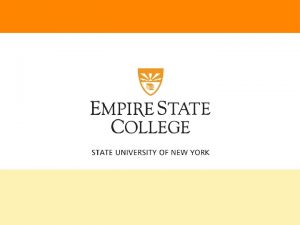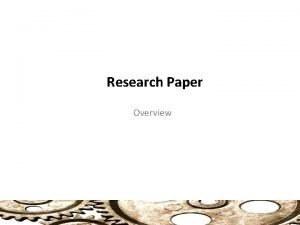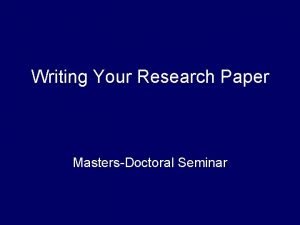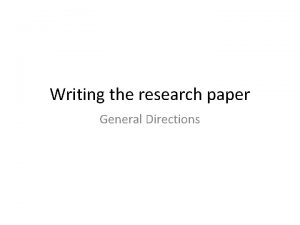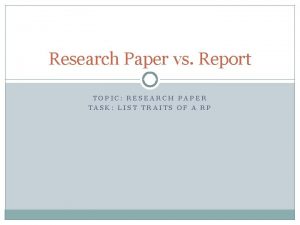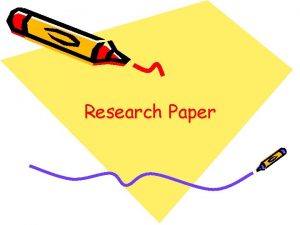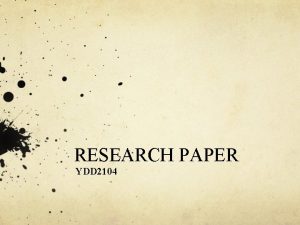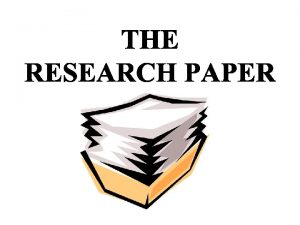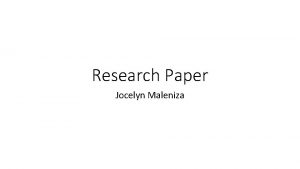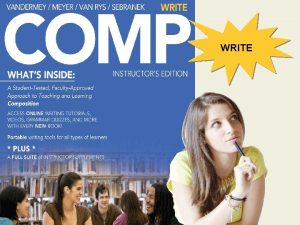RESEARCH PAPER 101 9 TH GRADE ENGLISH MS





















- Slides: 21

RESEARCH PAPER 101 9 TH GRADE ENGLISH MS. ANDERSON originally created by Mrs. Day, PHS

WHAT IS A RESEARCH PAPER? The main objective of a research paper is to use your ideas, accepted research methods, and reliable evidence to support a logical argument or provide information that is relevant to a given topic. Since the purpose of a research paper is to make a clear argument, a good paper will state the main argument, its thesis, as directly as possible. The main argument should organize the rest of the paper. Every section, paragraph and example used in a research paper should be explicitly linked to thesis.

WHAT IS A RESEARCH PAPER CONTINUED… All research papers should contain one key component: RESEARCH! This means that composing a research paper requires you (the researcher) to use sources other than your own opinion to find information that supports or explains your topic. Sources that are acceptable for research include (but are not limited to): books, internet articles, online databases, magazines, interviews, etc.

I’VE FOUND MY NOTES AND QUOTES… NOW WHAT? After you gather all of your note cards, you are ready to write your paper. Each paper should contain the following main parts: Introduction Body (History, People, Government & Economy, Culture, &/or Technology) Conclusion

INTRODUCTION The introduction of your paper needs to grab your reader’s attention. It may be a creative quote or and interesting fact. The end of your introduction (last sentence) needs to be your thesis statement. Your thesis should be the main point of your entire paper. We will discuss how to write a thesis at a later time.

BODY PARAGRAPHS The body of your paper needs to be divided into the 3 sections I have outlined for you (History, People, Government & Economy, Culture, &/or Technology) This is where you will display your research. Each paragraph needs to include AT LEAST two quotes. Quote should be incorporated using “The Quote Sandwich”.

THE QUOTE SANDWICH te uo Q e c u d Intro te Quo Ex pla in Qu o te

HOW TO USE ‘THE SANDWICH! Ways to Introduce Quotations X states, “_____. ” As the world-famous scholar X explains it, “____. ” As claimed by X, “______. ” In her article _______, X suggests that “_____. ” In X’s perspective, “______. ” X concurs when she notes, “_______. ” Way to Explain Quotations In other words, X asserts _____. In arguing this claim, X argues that _____. X is insisting that _____. What X really means is that ______. The basis of X’s argument is that ______. ***ALWAYS INCLUDE THE PROPER CITATIONS AT THE END OF A QUOTE***

PRACTICE MAKES PERFECT…. . Let’s just say the quote is “the rain in Spain stays mainly on the plain”. HOW WOULD WE USE THIS PROPERLY IN A PAPER? First, we would have to introduce it…. . As claimed by Eliza Doolittle, “the rain in Spain stays mainly on the plain. ” (My Fair Lady) Then, we would have to explain it… In other words, Ms. Doolittle asserts that the only area that receives any rain in the country of Spain in the level area of the plain land. Everywhere else in the country is dry and barren.

BODY PARAGRAPHS CONTINUED Each Body paragraph must FLOW from beginning to end (make sense and be on the same topic) Each paragraph must flow from one to the next as well.

CONCLUSION Your conclusion must be the last thing in your paper It sums up all of your research. It does NOT restate all of your quotations or facts, but gives a general idea of what you have found in your research process. It should include a re-stated thesis (in a different sentence structure).

MLA FORMAT Use white 8. 5 x 11 -inch paper Double-space the text of your paper Times New Roman font, size 12 Leave only one space after periods or other punctuation marks 1 inch margins Header that numbers all pages consecutively in the upper right -hand corner, one-half inch from the top. In the upper left-hand corner of the first page, list your name, your instructor's name, the course, and the date. Again, be sure to use double-spaced text Double space again and center the title. Do not underline, italicize, or place your title in quotation marks; write the title in Title Case (standard capitalization), not in all capital letters. Double space between the title and the first line of the text

MLA FORMAT…. MORE!!! This is what your 1 st page should look like!

YOUR TURN Choosing 3 of the following Disney quotes, I want you to introduce and explain quotes in a paragraph about “the valuable lessons learned through Disney movies”. "The very things that hold you down are going to lift you up. ” Timothy Mouse from Dumbo "The flower that blooms in adversity is the most rare and beautiful of all. " - The Emperor from Mulan "Even miracles take a little time. " - The Fairy Godmother “Ohana means family, family means nobody gets left behind. Or forgotten. ” -Lilo and Stitch “You think the only people who are people, are the people who look and think like you. But if you walk the footsteps of a stranger, you'll learn things you never knew. ”-Pocahontas “The past can hurt. You can either run from it or learn from it. ” -The Lion King

PLAGIARISM!!!!!!! What is Plagiarism? Many people think of plagiarism as copying another's work, or borrowing someone else's original ideas. But terms like "copying" and "borrowing" can disguise the seriousness of the offense: According to the Merriam-Webster Online Dictionary, to "plagiarize" means: to steal and pass off (the ideas or words of another) as one's own to use (another's production) without crediting the source to commit literary theft to present as new and original an idea or product derived from an existing source. In other words, plagiarism is an act of fraud. It involves both stealing someone else's work and lying about it afterward.

CONTINUED………. But can words and ideas really be stolen? According to U. S. law, the answer is yes. The expression of original ideas is considered intellectual property, and is protected by copyright laws, just like original inventions. Almost all forms of expression fall under copyright protection as long as they are recorded in some way (such as a book or a computer file). All of the following are considered plagiarism: turning in someone else's work as your own copying words or ideas from someone else without giving credit failing to put a quotation in quotation marks giving incorrect information about the source of a quotation changing words but copying the sentence structure of a source without giving credit copying so many words or ideas from a source that it makes up the majority of your work, whether you give credit or not Most cases of plagiarism can be avoided, however, by citing sources. Simply acknowledging that certain material has been borrowed, and providing your audience with the information necessary to find that source, is usually enough to prevent plagiarism.

SO, HOW CAN YOU BE SURE TO NOT PLAGIARIZE? ? ? The answer is SO very simple… YOU MUST CITE EVERTHING YOU USE IN YOUR PAPER. This means every quote and idea you get from an outside source needs to be sited in your paper. We will cover how to complete source cards later in the process, but you should know how to “cite” your quotes at this point. This also means your paper MUST include a Works Cited page to list all the things your paper uses, or cites.

WORKS CITED…. . WHAT EXACTLY IS IT? A works cited page is a list of all of the sources you took information from and used in your paper. If you complete your source cards correctly, you simply copy the information from your source cards onto the works cited page (in alphabetical order, by the FIRST word in the citation). If not, you must make corrections to your source cards and THEN list them in alphabetical order on you works cited page.

MLA FORMATTING FORTHE WORKS CITED PAGE Works Cited page on a separate page at the end of your research paper It should have one-inch margins It should have the same last name, page number header as the rest of your paper. Double space all citations, but do not skip spaces between entries. Indent the second and subsequent lines of citations five spaces so that you create a hanging indent List page numbers of sources efficiently, when needed. If you refer to a journal article that appeared on pages 225 through 250, list the page numbers on your Works Cited page as 225 -50. For every entry, you must determine the Medium of Publication. Most entries will likely be listed as Print or Web sources, but other possibilities may include Film, CD-ROM, or DVD. Writers are no longer required to provide URLs for Web entries. Capitalize each word in the titles of articles, books, etc, but do not capitalize articles (the, an), prepositions, or conjunctions unless one is the first word of the title or subtitle: Gone with the Wind, The Art of War, There Is Nothing Left to Lose. Use italics (instead of underlining) for titles of larger works (books, magazines) and quotation marks for titles of shorter works (poems, articles).

WHAT IT LOOKS LIKE…… Works Cited “A+ Research & Writing for College and High School Students. ” Internet Public Library. 8 June 2002. 20 Nov. 2003. < http: //www. ipl. org/div/aplus/>. Abilock, Debbie. “Information Literacy: Search Strategies. ” Noodle. Teach: 21 st Century Literacies. Updated 9 Sept. 2003. Noodle. Tools, Inc. 19 Nov. 2003. < http: //www. noodletools. com/debbie/literacies/information/5 locate/adviceengine. html>. “Air raid drill. ” War & Peace, Rationing and Rebuilding; 1940 s Life in Cottesloe, Western Australia School Days. 24 Nov. 2003. <http: //johncurtin. edu. au/1940 s/school>. “Checklist for Evaluating Web Resources. ” University of Southern Maine. 21 Nov. 2003. < http: //library. usm. maine. edu/guides/webeval. html>. < http: //library. louisville. edu/government/news/otherlinks. html>. Grassian, Esther. “Thinking Critically about World Wide Web Resources. ” UCLA College Library. Updated 6 Sept. 2000. 21 Nov. 2003. < http: //www. library. ucla. edu/libraries/college/help/critical/index. htm>. “Guide to Library Research. ” Duke Libraries. 2001. Duke University. 22 Nov. 2003. http: //www. lib. duke. edu/libguide/home. htm. > Keller, Cynthia. “Evaluation Is Essential. ” LSC 5540 -190 Information Searching, Retrieval, and Presentation Strategies. 22 Nov. 2003. Mansfield University. 22 Nov. 2003 < http: //keystone-university. net>. “Research and Documenting Sources. ” Purdue University Online Writing Lab. 2003. Purdue University. 21 Nov. 2003. <http: //owl. english. purdue. edu/handouts/research/index. html>. “Research Topics. ” Questia Online Library. 2003. 19 Nov. 2003

WORKS CITED ACTIVITY- PLACE THE FOLLOWING ENTRIES IN ORDER AS THEY SHOULD APPEAR ON A WORKS CITED PAGE. 1) “Architects. ” Career Information Center. Eds. Jacqueline Marais et al. 7 th ed. Vol. 4. New York: Macmillan Reference, 1999. 114 -16. 2) “Architects. ” Encyclopedia of Careers and Vocational Guidance. Eds. Holli R. Cosgrove et al. 10 th ed. Vol. 2. Chicago: J. G. Ferguson, 1997. 150 -53. 3) Mc. Kay, Dawn Rosenberg. “Building a Career in Architecture. ” About. com: Career Planning. 2008. The New York Times Company. 25 March 2008 <>. http: //www. careerplanning. about. com/cs/o… 4) “Career: Architects. ” College. Board. 2008. collegeboard. com, Inc. 25 March 2008 <>. http: //www. collegeboard. com/csearch/majo…
 Paper 2 aice general paper
Paper 2 aice general paper Qualitative research plan
Qualitative research plan Wipo dl 101
Wipo dl 101 Aice general paper essay
Aice general paper essay Whats a fragment sentence
Whats a fragment sentence Question b leaving cert english
Question b leaving cert english Aqa english language paper 1
Aqa english language paper 1 Edexcel english language
Edexcel english language Eduqas english literature past papers
Eduqas english literature past papers English language paper 1 2021 june
English language paper 1 2021 june Igcse question
Igcse question Dse english weighting
Dse english weighting English paper 2 timing
English paper 2 timing English literature paper 2
English literature paper 2 Edexcel gcse english language paper 2
Edexcel gcse english language paper 2 Aqa english language paper 2 rail disasters model answers
Aqa english language paper 2 rail disasters model answers English language paper 1 question 4 sentence starters
English language paper 1 question 4 sentence starters Fiction extracts for gcse english language
Fiction extracts for gcse english language Language paper 2 knowledge organiser
Language paper 2 knowledge organiser Edexcel gcse english literature past papers
Edexcel gcse english literature past papers Edexcel english lit gcse past papers
Edexcel english lit gcse past papers Edexcel english language paper 1
Edexcel english language paper 1


